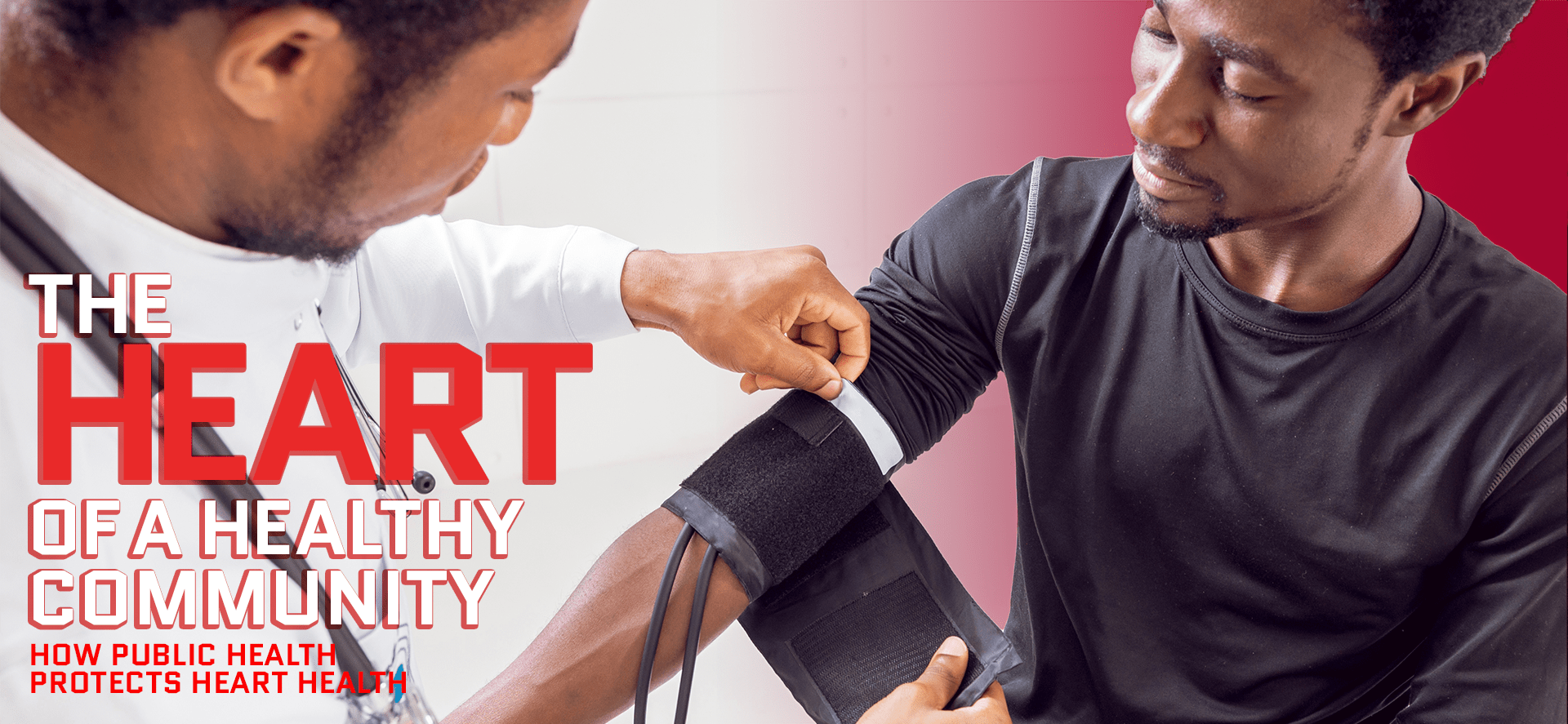The Heart of a Healthy Community
How Public Health Protects Heart Health
January 2024

Heart disease is the leading cause of death in the United States, and Southern Nevada is no exception. We talked with two Health District staff members with a pulse on our community who are working to keep Southern Nevada healthy.
Amineh Harvey is a Health Educator in the Office of Chronic Disease Prevention and Public Health Promotion. She has worked at the Health District for 14 years and coordinates activities like the Barber Shop Health Outreach Project and the Beauty Shop Health Outreach Project, signature programs that bring free blood pressure screening, education and health care referrals directly into barber shops and beauty salons in the African American community.
Erick Lopéz, PhD, is an Epidemiologist in the Department of Informatics and Epidemiology and has worked at the Health District for a year. He analyzes health data information and creates reporting tools that help policy makers identify health disparities in the community and develop programs to address them. Erick’s background in medical sociology gives him insight on the individual and societal factors that impact health behavior and outcomes.
This interview has been condensed and edited for clarity.
Perspective:
What are some of the signs that a person has a healthy heart?
Amineh Harvey
Health Educator
For adults, a normal blood pressure reading less than 120/80 and normal resting rate of between 60 and 100 beats per minute are both indicators of a healthy heart, but there are other factors to consider. Healthy eating, your age, your energy level throughout the day, your stress level—these are all things to look at when thinking about heart health. Visit your primary care provider for an annual wellness check and discuss your heart health.
Perspective:
Are there things outside of a person’s control that can affect heart health?
Amineh Harvey
Health Educator
Your family history and your age are examples of uncontrollable factors that can make you more susceptible to heart disease. But it’s important to point out there are things a person can do to reduce these risks and make healthier choices. Take small steps to improve your diet, manage your weight and increase your physical activity. If you smoke tobacco products, I encourage you to stop. We have programs to help people stop smoking, to be aware of their cholesterol and blood pressure numbers and take control of what they can change.
Erick Lopéz, PhD
Epidemiologist
There are some larger factors that could be out of someone’s control. Environmental factors like air pollution or lack of green spaces for exercise can negatively affect heart health. In addition, a lack of access to health care in marginalized communities, or information not being shared in a way that people can understand, can have a negative impact. The food environment—people not having access to healthy food—can as well. All of these factors need to be looked at on a community and policy level.
Perspective:
Is heart health just an individual problem? Why is it a concern for the entire community?
Erick Lopéz, PhD
Epidemiologist
It’s important to recognize there are disparities in heart disease between different groups. It’s a concern for the whole community because the rates of heart disease in different groups can influence public health policies. From an economic standpoint you look at health care costs and productivity lost due to heart disease. It’s also a burden on the overall health care system. If there are a lot of people seeking access to care for preventable heart disease, it can put a strain on the system when we’re dealing with other public health emergencies like COVID.
Amineh Harvey
Health Educator
When we started the Barber Shop Outreach Project, we looked at community data and found that heart disease is leading cause of death for Black males in Nevada. Specifically in the African American community, we found that 46% of Black men and similar numbers in Black women were diagnosed with hypertension, a leading factor in heart disease. So, we know it’s a concern here. Some communities don’t have access to quality health care or resources like insurance, so it’s not just an individual issue, it’s a community-wide concern
Perspective:
How does the Health District help protect heart health for individuals? For the community?
Amineh Harvey
Health Educator
Our website, GetHealthyClarkCounty.org, has a lot of free resources and educational programs about physical activity and nutrition. The website also has free apps for your phone. Walk Around Nevada and Neon to Nature are both great ways to get outside and get moving. We also have nutrition apps with healthy recipes and shopping tips.
For the Barber Shop Health Outreach Project and Beauty Shop Health Outreach project, we go into barber shops and beauty salons and provide free blood pressure screenings, education and resources on heart health and referrals to low-cost health clinics. I also teach a comprehensive heart health education program called With Every Heartbeat is Life, focusing on heart disease prevention, cholesterol, diabetes, physical activity, shopping and eating healthy on a budget, and smoking cessation, which are all significant risk factors for the African American community.
In our community education programs, we have trained nurses and health workers that can refer people directly to our Southern Nevada Community Health Center or other health care providers. That helps eliminate some of those barriers to care. On the other side of it, if someone is diagnosed with high blood pressure at one of the health care providers we work with, they let us know and we follow up with that patient with education about reducing their risk. We also sponsor the Healthy Hearts Ambassador Blood Pressure Self-Monitoring Program at the YMCA, making it free to the community. You can find out more about these classes on our website, www.gethealthyclarkcounty.org.
Erick Lopéz, PhD
Epidemiologist
One of the ways we’re helping protect heart health in the community is through the health equity dashboard we’re developing. This will let policy makers look at chronic conditions like heart disease and see where there are disparities in access to care and resources. We can also use the information to collaborate with community partners who work with these at-risk groups. Sometimes it can take a long time to get these policies in place. For example, we’ve been working on making UNLV a smoke-free campus for more than 20 years, and at the end of 2022 we finally achieved that goal. We’ll see the benefits of that patience and hard work for many years to come.
Perspective:
What is one step people can take to protect their hearth health?
Amineh Harvey
Health Educator
Our motto is “know your numbers.” Know where your blood pressure is so you know if you’re at risk. Also know that it will change as you get older so keep monitoring it.
Another thing is: take small steps to manage your blood pressure. Walking five days a week can lower your blood pressure by 10 points; quitting smoking lowers your blood pressure by five to 10 points. Every five-point decrease in blood pressure lowers your risk of a heart attack by 20%.
Erick Lopéz, PhD
Epidemiologist
I want to add it can be daunting to get back into activity, so start small. Instead of an hour, maybe do 15 minutes, three times a week and work up to five days. Action generates motivation, not the other way around.
Amineh Harvey
Health Educator
Right, remember that everyone’s journey is different. Figure out what’s best for you and tailor your heart health activities to your own needs and lifestyle.
You can find tips and tools for a heart healthy lifestyle at www.gethealthyclarkcounty.org, and at CDC | Heart Disease | Prevent Heart Disease.



